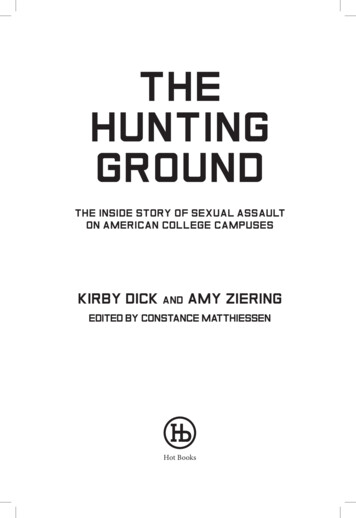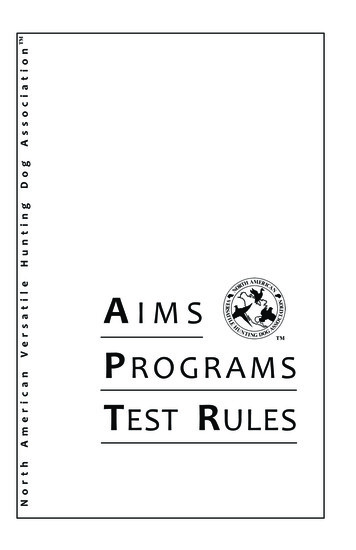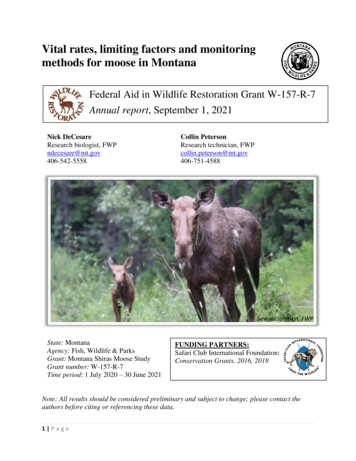
Transcription
THEHUNTINGGROUNDTHE INSIDE STORY OF SEXUAL ASSAULTON AMERICAN COLLEGE CAMPUSESKIRBY DICKANDAMY ZIERINGEDITED BY CONSTANCE MATTHIESSENHot Books
Copyright 2016 by Kirby Dick and Amy ZieringAll rights reserved. No part of this book may be reproduced in any mannerwithout the express written consent of the publisher, except in the case of briefexcerpts in critical reviews or articles. All inquiries should be addressed toSkyhorse Publishing, 307 West 36th Street, 11th Floor, New York, NY 10018.Hot Books may be purchased in bulk at special discounts for sales promotion,corporate gifts, fund-raising, or educational purposes. Special editions can alsobe created to specifications. For details, contact the Special Sales Department,Skyhorse Publishing, 307 West 36th Street, 11th Floor, New York, NY 10018 orinfo@skyhorsepublishing.com.Hot Books and Skyhorse Publishing are registered trademarks of SkyhorsePublishing, Inc. , a Delaware corporation.Visit our website at www.hotbookspress.com.10 9 8 7 6 5 4 3 2 1Library of Congress Cataloging-in-Publication Data is available on file.Cover design by Brian PetersonCover photo credit Richard DavisISBN: 978-1-5107-0574-6Ebook ISBN: 978-1-5107-0578-4Printed in the United States of America
ContentsIntroduction by Constance Matthiessen v1. Voices of Survivors: Four Stories of Sexual Assault 12. Sexual Assault in a Football Town by Amy Herdy 103. The Woman Who Stood Up to Harvard Lawby Kirby Dick and Amy Ziering 314. Fraternities and Sexual Assault 43Interview with Caitlin Flanagan on Greek Culture 45Interview with Doug Fierberg on the Power of Fraternities 55Before the Frat Party 675. Contributing Essays 76Not the Perfect Victim by Kamilah Willingham 77Dispatch from Hunted Ground by Roxane Gay 82Watching While Male by Andrew O’Hehir 86School of Trauma by D. Watkins 90Sexual Assault and the Media by Christina Asquith 94Sports on Trial by Jessica Luther 99Faculty and the Campus Anti-Rape Movementby Alissa R. Ackerman and Caroline Feldman 104Familiar Territory by Erin Ryan 110The Ambitious Storytelling of The Hunting Groundby Wendy Levy 113
ivt h e hu nt ing g rou n dTarget Rape on Campus by Diane Rosenfeld 117Facing Each Other by Lisa C. Knisely 1246. A Conversation with the Filmmakers 1287. The Numbers Don’t Lie: The Statistics of Sexual Assault in Collegeby Kirby Dick 1418. How to Get Involved 146Film Information 149Sources 160
Introductionby Constance MatthiessenThe Hunting Ground, the powerful documentary by filmmakers Kirby Dick and Amy Ziering, begins with exuberant video clips of high school seniors learning that they’ve beenaccepted by their top-choice colleges. As “Pomp and Circumstance” surges in the background, one girl’s face goes from dreadto stunned joy, another dissolves in tears, a third screams andleaps to her feet, joining her family in a giddy dance around thedining room.It’s a dream most parents cherish: sending their child to college. The dream features erudite professors, inspiring classes, andfriendships to last a lifetime—all set against a backdrop of statelybuildings and quads shaded by graceful trees.On its face, Annie Clark’s experience at the University of NorthCarolina, Chapel Hill, is one every parent would wish for theirchild. “I really had a good time there,” she recalls early in the film. “Ilearned a lot. I loved my professors. The first few weeks I made someof my best friends, and we’re still really close to this day.”Clark, an athlete and North Carolina native, has a round,open face and a 1,000-watt smile. But her smile fades and her facetightens as she finishes, almost matter-of-factly, “But two of us weresexually assaulted before classes even started.”v
vit h e hu nt ing g rou n dCampus EpidemicThe Hunting Ground tells the stories of dozens of students whosecollege experience is marred by sexual assault. The film’s director,Kirby Dick, and producer, Amy Ziering, are the team that made thedocumentary The Invisible War, an exposé of sexual assault in themilitary that sparked national outrage, won two Emmy Awards, aPeabody Award, and was nominated for an Academy Award. Thatfilm compelled the Pentagon to change policies and was the catalystfor dozens of major reforms passed by Congress and signed into law.When the filmmakers screened The Invisible War at collegesand universities, students repeatedly approached them to talkabout sexual violence on their campuses. Dick and Ziering heardso many disturbing stories that they shelved the project they wereworking on and started making The Hunting Ground instead. Whatfollowed was two years of in-depth investigative work. Along withtheir team, they visited dozens of campuses, conducted hundredsof interviews, and tracked a fledgling movement of courageousstudent activists. The result is a powerful and frightening portraitof sexual violence on campuses across the country—from partyschools to the most exclusive bastions of the Ivy League.The statistics are stunning: More than 20 percent of womenand more than 5 percent of men who attend college are sexuallyassaulted.Fraternities and AthleticsWhat’s behind this widespread sexual violence? The HuntingGround highlights two fixtures of campus life often associatedwith sexual assaults: fraternities and athletics.Fraternities, which today are the center of the social sceneat many colleges, are also the setting for many sexual assaults
Introductionviiat colleges around the country. While some fraternities foster aspirit of community and inclusiveness that benefits their members and their schools, others perpetuate a macho “bro” culturethat encourages binge drinking, misogynistic attitudes, and a packmentality. This fierce loyalty among fraternity members oftenworks to keep sexual assault cases under wraps, so it’s difficultto say how many attacks occur at college fraternities each year,but, according to insurance reports, sexual assaults comprise thesecond-highest number of claims against fraternities.College athletes have been linked to a number of highly-publicized campus assaults; a recent notable case is the accusations ofrape against Florida State’s quarterback Jameis Winston. Whilethe vast majority of athletes would never assault anyone and arehorrified by these crimes, research shows that a small minority ofathletes (4 percent) commit a disproportionately high number ofassaults (19 percent). In many of these cases, the accused athleteis protected by the school and its athletic program because of hisimportance to the team. As educator and former NFL quarterback Don McPherson tells Dick and Ziering: “I really do believethe vast majority of student athletes are worthy of our admiration.But when you have 18- to 22-year-old kids who are celebrities itcreates a toxic environment for a lot of bad behavior. . . . There’s amultibillion-dollar industry that wraps around these young men,and if you don’t think that they’re part of a culture of entitlement,just look at the fanfare that’s around college football.”While these three factors play a role in many sexual assaults,they don’t explain why these incidents keep occurring at collegeafter college with mind-numbing regularity. Watching The HuntingGround, you realize that campus assaults keep happening because
viiit h e hu nt ing g rou n dno one is stopping them: Perpetrators keep committing thesecrimes, quite simply, because they can.Protecting a BrandIn fact, colleges have done little to stop violence on their campuses,as The Hunting Ground (both the film and this book) make clear.When Annie Clark reported her rape to an administrator at theUniversity of North Carolina, the woman replied, “Rape is like afootball game, Annie, and if you look back on the game what wouldyou do differently in that situation?”Other college students report similarly victim-blamingresponses from the college administrators they turn to for help:“What were you wearing?”“What were you drinking? How much did you have to drink?” “Did you say no? How many times did you say no? How did yousay it?”Over the course of The Hunting Ground, students’ assault reportsare repeatedly ignored. Or the investigation is stalled. Or the punishment is a perfunctory slap on the wrist. At some colleges, perpetrators have been given ludicrously small fines, or assigned a paperto write. At Stanford University, to give just one example cited inthe film, 259 sexual assaults were reported between 1996 and 2013,but only one student faced expulsion. In fact, according to researchby The Huffington Post, less than one-third of students found guiltyof campus sexual assault are expelled. Nationwide, far more students are expelled for cheating than for sexual violence.A 2014 report commissioned by Senator Claire McCaskillfound that countless campus sexual assaults are never even
Introductionixinvestigated. Researchers found, for example, that 40 percent ofcolleges had not conducted a single assault investigation in fiveyears. In addition, “More than 21 percent of the nation’s largest private institutions conducted fewer investigations than thenumber of incidents they reported to the Department of Education, with some institutions reporting as many as seven timesmore incidents of sexual violence than they have investigated,”the report found.Why can’t the best minds at the top educational institutions inthe country get a handle on this problem?The fact is that higher education is big business: Total annualcost per student at many colleges now exceeds 60,000 a year. Forinstitutions vying for the best and brightest students, sexual assaultrepresents a public relations nightmare. What parent would electto send their child to a college—no matter how prestigious—wherestudents were at risk of assault? College administrators have moreincentive to brush off assault reports than to aggressively pursueand expel perpetrators. “If a student comes to an administratorwith a problem, it’s not as if the administrator wants that studentto be harmed,” explained Claire Bond Potter, a professor at TheNew School in New York City. “It’s not as if the administratorwants the harm to be perpetuated, but their first job is to protectthe institution from harm, not the student from harm.”When campus assaults are reported to local law enforcement,results vary widely depending on the incident and the municipality,but many cases are never pursued at all. According to the FBI, forexample, just 26 percent of rapes reported to police lead to arrest.Many of these local police departments are under the shadow ofthe ivory tower in their communities, where the university is oftenthe biggest employer in town.
xt h e hu nt ing g rou n dIt’s no surprise, then, that 88 percent of women raped on campus do not report the assault (the McCaskill report concluded thatrates are even lower, finding that only 5 percent of women reportcampus rape).Signs of Change?Over the last few years, as countless reports of campus assaults havehit the headlines, college students have started to get angry—andto fight back. Demonstrations have flared up at colleges across thecountry. Columbia University student Emma Sulkowicz carried amattress to classes and across the stage at graduation to protestthe fact that the student she reported as having raped her was notexpelled. Three Berkeley women recently filed a federal complaintwith the Department of Education and university faculty members and college alumni are adding their voices through organizations like FAR (Faculty Against Rape) and Dartmouth Change, agroup of alumni, faculty, parents, and students formed in responseto sexual violence and harassment at the college.UNC students Annie Clark and Andrea Pino are building anational network of student survivors. Their organization, EndRape on Campus, helps survivors develop strategies to increaseawareness and pressure on college administrators.Clark and Pino’s primary tool is Title IX, a federal civil rightslaw that prohibits sex discrimination—including sexual harassment and sexual violence—in education. Clark, Pino, and otheractivists are using Title IX complaints to pressure colleges toensure that their campuses are free from sexual harassment andviolence.The issue of campus assault has sparked attention in Washington, DC, as well. The Obama administration launched civil rights
Introductionxiinvestigations at more than 150 colleges and universities. PresidentObama and Vice President Biden have both spoken out forcefullyagainst sexual violence, and legislation is in the works in Congress.Backlash from the SkepticsThe exposure of campus sexual assault has triggered backlash,with commentators questioning the epidemic.The skeptical voices grew even more clamorous after aNovember 2014 Rolling Stone report of a gang rape at a University of Virginia fraternity. The article turned out to be based onflawed reporting and was ultimately retracted. The incident fueledcharges of a so-called “rape-hoax culture” on college campuses andcritics accused women of lying about being raped to get attentionor revenge. But statistics consistently show that false reporting isno more common in incidents of sexual assault or rape than anyother crime. (The uproar over the Rolling Stone article obscuredthe University of Virginia’s dismal record on campus assault: UVAhas never expelled a single student for sexual assault, even whenthe student admitted the attack.)Some critics also scoff at the one-in-five figure widely citedas the number of female college students who experience sexualassault during their college career. Forbes, for example, called outPresident Obama for using the statistic in a January 2015 speech:“One in five is a staggeringly high number, one that has led to amoral panic about the issue of sexual assault on campus.” But thetruth is that national studies over several decades have repeatedlyvalidated the one in five figure. In fact, in just the past year, twomajor studies by the American Association of Universities andthe Department of Justice have put the number at closer to one infour. (See Chapter 7: The Numbers Don’t Lie).
xiit h e hu nt ing g rou n dSince The Hunting Ground’s release, a few critics (most ofwhom are associated with institutions critiqued in the film) haveattempted to disparage it by aggressively trying to discredit thewomen whose stories are highlighted in the film. These criticshave been unable to identify any substantiated factual errors, andtheir efforts to damage the film or prevent it from being seen havefailed. In fact, Jameis Winston’s attorneys threatened CNN with alawsuit if it showed the film, but CNN stood by the film’s reportingand aired it on their channel in November 2015. These attacks arein keeping with what the film shows institutions have historicallydone regarding sexual assault: rather than address these problemsat their school, they attack the press and the people who reportthese crimes.Despite these attacks, The Hunting Ground has had an extraordinary impact on the sexual assault dialogue on college campusesnationwide. The film has screened at more than 1,000 universities,high schools, community centers, and government offices acrossthe country, sparking long-silenced debate and policy change.The film has had high profile screenings at the White House,Department of Justice, Office of Civil Rights, Department of Education, NCAA, and a number of state legislatures. When GovernorCuomo of New York screened the film for legislators, they swiftlypassed “Enough is Enough,” a comprehensive new bill aimed atstopping sexual assaults on all New York college campuses. Globally, the film has instigated campaigns to combat sexual violenceon campuses. In Australia, the film triggered a country-wide campaign called “The Hunting Ground Australia” to address sexualassault, enlisting nearly all the major universities. At the AcademyAwards in February 2016, Vice President Joe Biden introducedLady Gaga, and “Til It Happens To You,” the theme song from the
Introductionxiiifilm. Gaga was joined on stage by 50 survivors, many of whomwere in the film, and the moving performance was widely considered one of the highlights of the event and one of the most powerful moments in the history of the Academy Awards.Moral High GroundToday, at colleges and universities around the country, administrators are scrambling to develop policies and procedures to dealwith sexual violence. New sexual assault prevention programs arebeing unveiled, and disciplinary procedures are being revised andretooled. The University of California announced a comprehensive sexual assault prevention program that is mandatory for students on all 10 UC campuses. Some colleges are imposing newrules on fraternities; others are cracking down on alcohol abuse(Dartmouth and several other schools have banned hard alcohol).Still, it remains to be seen how effective any of these reforms willbe, since many college leaders remain unwilling to acknowledgethe problem—especially in their own backyards. A 2015 survey ofcollege and university presidents by Inside Higher Ed found thatless than a third agreed that sexual assault is prevalent at Americancolleges and universities, and only 6 percent said that it was common at their institution.Toward that end, psychologist David Lisak challenges college leaders to step up and tackle the problem of sexual assault:“There is this moral high ground in higher education that is sitting vacant,” Lisak says. “What I haven’t yet seen anywhere . . . is a[college] president who decided that whatever it takes, it has to bedone. That’s what leadership is.”
xivt h e hu nt ing g rou n dThis book tells the story behind this groundbreaking film. Weshare the accounts of sexual assault survivors and provide an indepth examination of the case of one of the young women whoaccused former FSU quarterback Jameis Winston, now a risingNFL star, of rape. We’ll learn more from activists in the trencheswho are working to increase awareness of these crimes, and oftenpaying a high price for doing so. We’ll learn more about the making of The Hunting Ground, and the reactions to the film since itspremiere. We’ll present writers from a variety of backgrounds andperspectives, who weigh in on the issue of sexual assault. Finally,we’ll point you to resources so you can learn more about campussexual assault and what needs to be done to end this epidemic.
1Voices of Survivors:Four Stories of Sexual AssaultMuch of the power of the The Hunting Ground comes fromthe students who agreed to appear in the film and talk aboutbeing sexually assaulted.The issue is now in the spotlight because of young people likethese, who’ve had the courage to come forward and say, Yes this ishappening. It happened to me.Sexual assault survivors not only experience shame and guilt;many develop Post-Traumatic Stress Disorder (PTSD). Symptomsof PTSD include flashbacks, insomnia, anger, anxiety, and depression. Survivors often isolate themselves, avoiding places and situations that remind them of the attack; some relive the assault infrequent, vivid nightmares. They are at higher risk of substanceabuse and suicide.As the medical director of San Francisco General Hospital’sTrauma Recovery and Rape Treatment Center, Dr. Laurie Richersees many sexual assault survivors, including students from BayArea colleges and universities. Recovery takes time and depends1
2t h e hu nt ing g rou n don many factors, according to Richer, including the severity of theattack, and the individual’s previous history of trauma. Some people are simply more resilient than others or have more resources,including support from friends and family members.Richer describes two of her clients, both survivors of campussexual assault: “I’ve seen one of these women learn to express herself and move on from it,” she said. “The other student can’t goto class; she keeps having anxiety episodes. She’s falling behind inschool. Her world is crashing around her.”Many students who experience sexual assault drop out of college, many lose scholarships, and some become outspoken advocates for change. Almost all move in the world with a wariness theynever had before. “All they wanted to do was get a college education,” Richer points out. “And now the course of their life haschanged: They’re living a life that’s not at all what they planned.”Hundreds of students came forward to talk to filmmakers Kirby Dick and Amy Ziering for The Hunting Ground. Theseyoung people represent a broad cross section—including male andfemale, minority and white, straight and LGBTQ—from collegesacross the country. Many of these students make only a briefappearance in the film; others don’t appear at all. We’ve included afew more of their stories here.DanielDaniel (not his real name) was sexually assaulted during hisfreshman year at one of the most prestigious Ivy League collegesin the country.It was spring semester and Daniel, who is gay, had recentlygone through a breakup. Some friends thought he needed to get outand have some fun, so they took him to a party at an upper-class
Voices of Survivors: Four Stories of Sexual Assault3dorm. It was late in the evening and all of Daniel’s friends had leftthe party when an older student approached him and asked him todance. The older student became aggressive, and sexually assaultedDaniel. Daniel didn’t know what to do: The room was dark, and hewas embarrassed and intimidated.He left as quickly as he could after the assault, and tried toput the incident out of his mind. “For a while I just didn’t reallyacknowledge it,” Daniel said. “I kind of thought of it as a badhookup, because you’re taught that assault is something that happens to women.”But Daniel couldn’t stop thinking about what happened and howviolated he felt. He sought therapy, but he didn’t report the incident,even after he learned that his assailant had attacked other students.“I never thought about reporting because I had heard such horrorstories from people about what happened if you went to the officethat handles this type of situation,” he says. “Generally, the assailantwas never charged with anything, was never kicked out of school, andtypically nothing ever happened. So it’s almost a matter of, ‘Why am Igoing to go forward if I’ll just be standing out there alone?’”The college’s iconic status and exclusivity also discouragesreporting, Daniel says: “It’s such a recognizable name and becausewhen you first get the letter you feel so privileged to go there, youdon’t want to do anything that jeopardizes that.” Minority and lowincome students are particularly hesitant to speak up: “It’s kind ofa matter of, ‘If I go to the administration, will they even really carebecause my father didn’t donate millions?’”Males who are sexually assaulted are often reluctant to report,research shows. Men often feel ashamed that they didn’t stand up totheir attacker, or they feel complicit if they experience arousal, eventhough this is a normal physiological response.
4t h e hu nt ing g rou n dAssumptions about what it means to be a man also make itmore difficult to seek help, according to Daniel. “As men we’retaught to always want sex, that it’s something we should never sayno to. We’re taught that men stereotypically think about sex everyfive seconds, that this is at the forefront of our brains. We even referto it as ‘scoring,’ as if it’s a game, or something that we can win. Toadmit that this is something you didn’t want is to almost strip yourself of the stereotypical ideal of manhood or masculinity.”HopeHope Brinn took nine AP classes, was a member of the math leagueand captain of the Science Olympiad team in high school. Whenshe went to a party during her third week at Swarthmore College, itwas the third one she’d ever been to.The party was at a fraternity, one of just two fraternities atSwarthmore. At the party, a student from the fraternity approachedHope, put his arm around her, and steered her away from herfriends. At first, she enjoyed the attention: “He was really nice, andhe was sweet-talking me, and he handed me drink after drink, andyou know, I was flattered; I was very, very flattered. Because I wentto an all-girls Catholic high school; I wasn’t really experienced atall in that way.”He suggested they go outside, and it was there that he pinnedher against a wall, pulled off her clothes and sexually assaulted her.Hope tried to get free, but he wouldn’t let her go. A friend finallycame outside to look for Hope and helped her get away. The tworan away from her assailant, who chased them all the way back tothe friend’s dorm.Hope initially brushed off the incident. “I thought, He’s justa weird drunk guy. It’s not a big deal. Just a gross frat brother. I
Voices of Survivors: Four Stories of Sexual Assault5should have known.” But the man wouldn’t leave her alone: He keptapproaching her at parties and pressing her to sleep with him; atother times he belittled and tried to humiliate her. Meanwhile hetold his fraternity brothers that she was obsessively pursuing him.She later found out that the fraternity had a derisive nicknamefor her, and that they made fun of the frat brother for hooking upwith her because they considered her so unattractive. At one point,someone broke into her room while she wasn’t there, and the realization caused knots in her stomach.Over time, Hope learned that the student had assaulted otherwomen at Swarthmore, so she decided to report him. As a result,she was banned from the fraternity, and other friends turned onher. She didn’t care about the ban but believes the gesture reflectsan ethos that is responsible, at least in part, for Swarthmore’s sexualassault problems. “It’s this ‘don’t dick a bro’ culture: You protectyour brothers at all costs, in all circumstances, no matter what,” shesays. “It’s this fake notion of brotherhood that I really, really can’twrap my mind around.”Despite the retaliation Hope received from fellow students andeven some administrators at the college, she didn’t stay silent. Shejoined other students in a Title IX complaint against the college,and reached out to survivors through a group called SwarthmoreAssault Prevention and Survivor Advocacy. She and another student started a chalking campaign, scrawling messages about sexualassault in chalk around the campus.There was a moment when Hope didn’t speak up, and ithaunts her. It happened before she reported her attack, before sheacknowledged that she’d been sexually assaulted—even to herself.“I was coming back from my dorm and I saw my assailant walkinginto his room with a very, very intoxicated freshman who was not
6t h e hu nt ing g rou n deven really able to hold herself up,” she recalls. “And I stood there,and he saw me, and I just stood outside of his door for a coupleminutes and thought, Should I call public safety? Should I call public safety? And then I said to myself, Well I don’t know if he’s goingto assault her. Now of course, I really did know. But I kept talkingmyself out of it. And I just—I still regret that to this day.”NatassjaThe following survivor, Nastassja Schmiedt, identifies as genderqueer, and goes by the gender neutral they/them pronoun.Nastassja Schmiedt always wanted to go to an Ivy Leagueschool. “I could list the Ivys from the time that I was five years old,”they recall. They were a top student at their high school in Miami,where they were one of few black students. Despite Nastassja’sacademic success, they were nervous when replies from collegesbegan rolling in. “I remember I got the acceptance letter fromDartmouth and I did a cartwheel,” they said. “It was really, really,really exciting.”During their freshman year at Dartmouth, Nastassja came outas LGBTQ. Later that same year, Nastassja was sexually assaultedby a woman. The two were at a fraternity party, and the woman,who was a casual friend, kept giving Nastassja drinks. Later shewalked Nastassja, who at that point was very drunk, back to theirdorm and assaulted them.Nastassja repeatedly told the woman that they did not want tohave sex. The woman later told Nastassja that she had intentionallygiven Nastassja drinks in order to have sex.Nastassja never reported the incident, and their reasons fornot doing so reflect the complicated reality minority and LGBTQassault survivors face. Nastassja was reluctant to report, in part,
Voices of Survivors: Four Stories of Sexual Assault7because their assailant was a gay woman of color—part of a groupthat Nastassja says is already marginalized on the Dartmouth campus. Nastassja also had little faith that Dartmouth administratorswould pursue their case. The word around campus was that administrators typically did little to address assault reports; they assumedadministrators would be even less likely to investigate an assault bya woman.According to Nastassja, other LGBTQ survivors they’ve talkedto show a similar ambivalence about their experience. “Their reaction is often, ‘Is this something that is wrong? Or is this somethingthat happens to people like me? Because if it’s something that justhappens to people like me, why would anyone care?’” Nastassjasaid.While many campus assault survivors who have gone public have been white and heterosexual, research shows that in thegeneral population, minorities and those who identify as LGBTQexperience higher rates of sexual violence than whites and heterosexuals do. While there has been little research on college campusesabout this aspect of this issue, a 2015 campus survey at the University of Michigan found that LGBTQ and minority students therewere shockingly twice as likely to experience sexual assault as theirstraight and non-minority peers were.Nastassja went on personal leave from Dartmouth beforethe end of their sophomore year, after experiencing retaliation fortheir activism against sexual assault and other forms of campusviolence. They co-founded Spring Up, a multimedia activist collective that
In fact, colleges have done little to stop violence on their campuses, as The Hunting Ground (both the film and this book) make clear. When Annie Clark reported her rape to an administrator at the University of North Carolina, the woman replied, "Rape is like a football game, Annie, and if you look back on the game what would










